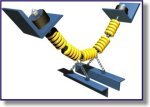 |
Troughing idlers are found on the carrying-side, along the length of the conveyor. On any particular conveyor these idlers are identical, as are the bases. |
Beginners Guide
Types and functions of idlers
It has been stated above that there are basically two types of idlers namely, carrying and return idlers.
Within these categories however, there are a number of different designs of idler sets which have developed as a result of particular applications, the need to minimise the stress imposed onto the belt and the environment in which the conveyor operates.
These different types of idlers are described below, together with a functional explanation for each.
- Troughing idler sets
 |
Troughing idlers are found on the carrying-side, along the length of the conveyor. On any particular conveyor these idlers are identical, as are the bases. |
|
Troughing idlers can comprise 3-roll or 5-roll idler sets (seen above and right). The 5-roll idler configuration offers a more uniform cross-section which results in a greater nett carrying capacity for the same belt width and belt speed. |
Garland idlers are another type of troughing idler which is used.
|
The garland idler set (see thumbnail right) comprises either 3-roll or 5-roll idlers joined together at the ends of their respective shafts by special lugs, to form a continuous 'chain' of idlers. |
On either end of this 'chain', the shafts are connected to an attachment bracket which enables the idler set to be attached to the conveyor stringer structure.
Garland idlers are used predominantly on yard conveyors, shiftable conveyors, and dump conveyors, etc. where the alignment of the conveyor structure may not be completely correct due to the mobility of the conveyor, or the ground conditions onto which the conveyor structure in founded.
- Transition idler sets
|
Transition idlers are found at either end of the conveyor, adjacent to the head and tail pulleys. These idler sets comprise standard idler rolls however the bases into which these rolls are fitted, have a smaller troughing angle to that of the rest of the troughing idlers on the conveyor. |
The reason for this is that the conveyor belt is flat as it passes over the pulleys, under high tension. As the belt changes its' form to a full trough of say 35 degrees (i.e. from tail pulley to full trough angle), the belt must be supported through this transition zone. If the belt was fed directly into a full trough from the tail pulley, the belt edges would be over-stressed and damage would result.
Similarly, as the troughed angle changes to zero at the head- end, transition idlers provide support through the transition zone.
The number of transition idlers depends on the trough angle of the conveyor. In the case of a 45 degree trough angle, 2 or 3 transition idler sets would be used at either end of the conveyor. These idler sets would have incrementally greater trough angles of say 15, 20 and 35 degrees through the transition zone leading up to 45 degrees.
As with troughing idlers, transition idlers are available in fixed bases or the garland configuration.
- Impact idler sets
This cushioning ability of impact idler sets allows the energy associated with the impact to be absorbed more efficiently and with much less detrimental effect to the belt.
|
Impact idler rolls are either mounted into rigid, fixed base frames or can be manufactured in garland-type sets, depending on the application. |
 |
- Return idlers
The mass of the return belt is the only load that return idlers are required to support. As such, return idler sets are spaced at two to three times the pitch of their equivalent carrying-side idler sets. Return idler sets usually have one or two rolls per idler set, for similar reasons.
The trough angle of the 'V' return idler is usually 10 degrees and this feature has been developed to assist with belt training along the return strand.
- Training Idlers
In cases where the belt misaligns, severe damage can be done to the belt should the belt rub against a fixed structure, the head chute or conveyor stringers.
Example of training idlers are shown above and can be viewed by clicking on the thumbnails.
